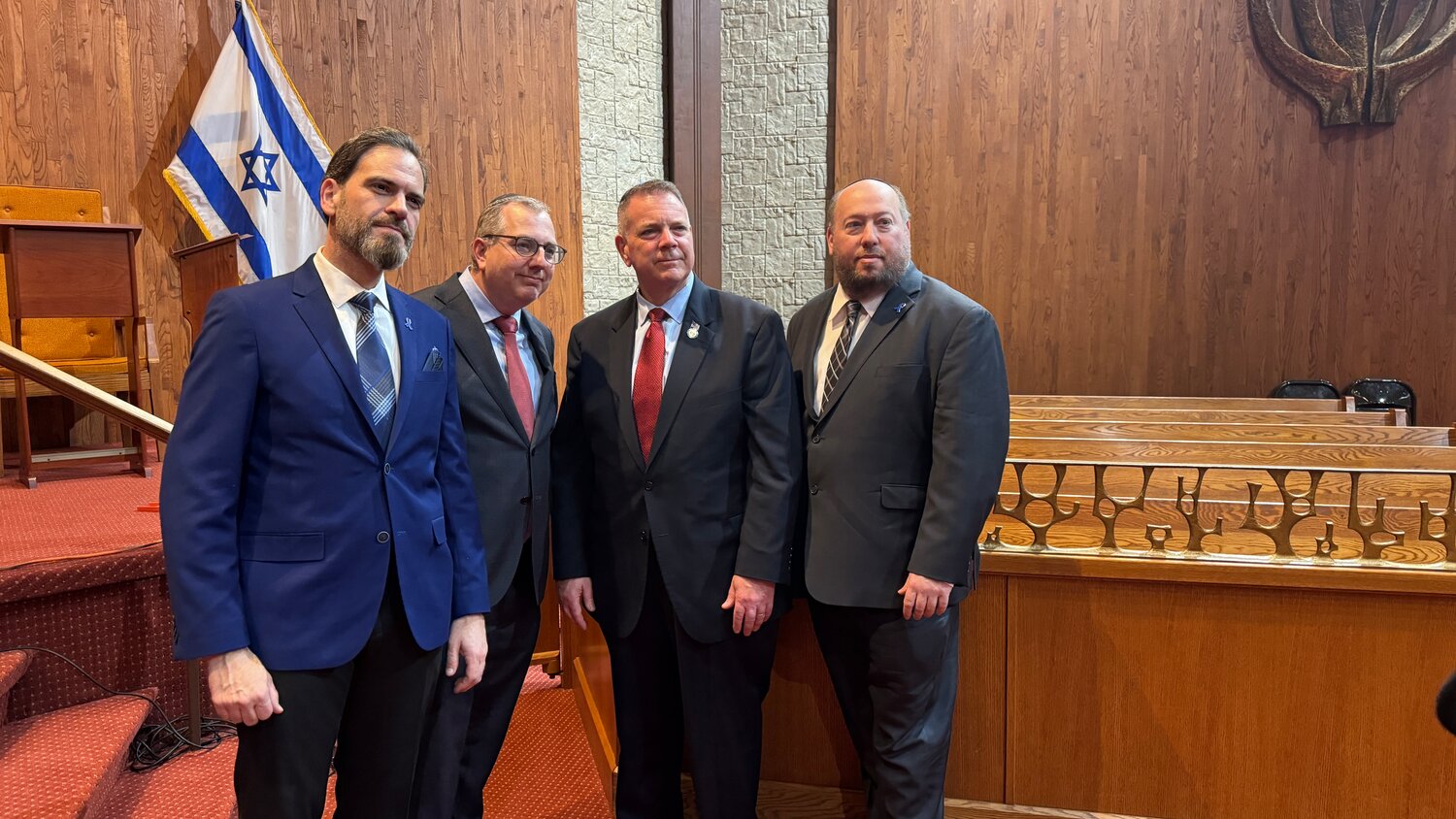Survivors of Oct. 7 attacks speak to Merrick-Bellmore community
As the war between Israel and Hamas continues, Jewish pride in Merrick and Bellmore remains steadfast. At Congregation Ohav Shalom last week, the Merrick Bellmore Jewish Community Council presented “Rebuilding After Oct. 7 — The Story of Kibbutz Nir Oz.” Speakers from Israel, who experienced the initial attacks, joined members of several congregations who gathered to hear their stories and to learn about ways that American Jews can help communities in Israel.
“This week, the cover of the most recent edition of The Economist magazine takes a picture of a lone Israeli flag, covered in grime,” Rabbi Ira Ebbin, of Ohav Shalom, said. “It’s blowing in the desert winds, being held up by a single twig. The title of the article simply states, ‘Israel Alone.’”
“Are Israel and its citizens all by themselves in the world?” Ebbin asked.
“There’s one thing that I’m absolutely certain about,” he went on. “The answer to the question … is unequivocally no. Israel is not alone. Since that horrific day on Simchat Torah, our prayers, our tears, our thoughts and our resources have all been centered around our brothers and sisters.”
Shani Goren and Omar Vehab, residents of Kibbutz Nir Oz, recounted where they were, and what happened to them, when Hamas terrorists stormed into their community. Nir Oz is near the Gaza border, and Hamas killed, injured or took captive about one-quarter of its residents.
Goren, who addressed the crowd in Hebrew through a translator, was kidnapped. She spent 55 days as a hostage in Gaza.
She recalled that on the morning of Oct. 7 there was a Code Red warning issued by the Israel Defense Forces in communities near the Gaza border. A Code Red usually warns of incoming rockets, so she went into her home’s safe room and tried to contact her family members to figure out what was happening.
Members of Hamas entered Goren’s home and threw a grenade into the safe room, but it didn’t explode. Then five terrorists walked into the room, and discussed what to do with her.
“I asked them a few times, three times, not to take me,” she said. “I refused. But each time that I refused they had weapons towards me.”
They forced her to leave her home with them. “I realized that the army was not there — there was nothing we could do,” she said.
Goren and other hostages were moved into a small house in Gaza, where they stayed for two weeks before they were moved to a hospital. She was held in a room with two young boys and an older woman, she recounted. The children told her that Hamas had shown them photos of what was left of the Nova music festival, where over 300 people died, as well as photos of women who had been raped.
Goren passed time with the boys, she said, by playing games. They were largely unaware of what was happening outside, in Israel or in Gaza.
Vehab said he had the “pure luck” of not being home the morning of the attacks. He was in Tel Aviv when he heard news of what was happening. He headed home, but was unable to enter the kibbutz because it was blocked off by emergency personnel. He watched “from the side” and tried to learn what was going on through text messages and videos from friends and family who were still inside.
At around 10 a.m., he heard from his mother that Hamas had charged into his family’s home and shot everyone, including his father, who died in the attack. Friends who were visiting from Germany, and staying in Vehab’s apartment, were also killed.
“I may have had pure luck, but most of the people that I love — my family, my friends, Shani here, didn’t have the privilege,” he said.
Much of the kibbutz was destroyed, Vehab said, and months later, residents who survived or were not taken captive are still trying to make sense of what they experienced.
“The difficulty is, we have to try to think about going back and living our lives,” he said. “And that’s what we are trying to figure out these days. The only thing that can make us stay strong and feel secure is being together.”
Vehab said that people who lived in Kibbutz Nir Oz chose a simple life, built around agriculture and education.
“The next year is really going to be tough for us, as we try to get back on our legs,” he said. “The problem is that it didn’t end for us. We are still suffering.”
Attendees were invited to text questions for Goren and Vehab, and many asked simply, how does Kibbutz Nir Oz recover and rebuild?
“We want to build a community that would continue what was, but not in the kibbutz,” Goren said. “It’s like a monument, or place that existed. We want to stay together as a community and keep the community going, but in different place.”
“We so appreciate that you came to our community to share your stories,” Ebbin said. “… I know it was difficult. It was so important for us to hear.”
There were flyers with information about how the Merrick-Bellmore community can help Nir Oz rebuild. “As we said before,” Ebbin said, “that is what the Jewish people have always done.”

 80.0°,
Partly Cloudy
80.0°,
Partly Cloudy 




